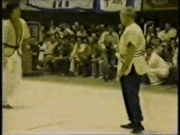I think this is in the same concept of trying to map out a conversation-an impossible task. With a conversation, I say "Hi how are you", there are 50 different ways someone might respond, if I have a response to each (or even group them together to 10 ways), then they respond to that in 50 different ways. And it seems like an impossible task. Yet pretty much any of us can carry out a conversation.
It does much more to teach people general principles and give them experience to learn how to adapt and choose from the situation that they're in, then it does to have them memorize specific responses to specific attacks/counters. The conversation version of this would be to teach them basic counters and blocks, have people throw punches/kicks/try to grab them, and they learn to respond to those, the same way kids learn to respond to unexpected (to them) responses to conversations.
It's why pressure testing is so important.
It does much more to teach people general principles and give them experience to learn how to adapt and choose from the situation that they're in, then it does to have them memorize specific responses to specific attacks/counters. The conversation version of this would be to teach them basic counters and blocks, have people throw punches/kicks/try to grab them, and they learn to respond to those, the same way kids learn to respond to unexpected (to them) responses to conversations.
It's why pressure testing is so important.

